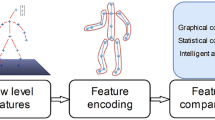Abstract
Body tracking sensors have become an integral part of the physical therapy not only as a motivational tool used by games but also as a diagnostic instrument. Skeletal tracking helps to analyze and quantify human motion and thus can provide tangible results from therapy sessions. Markerless skeletal tracking with depth sensing cameras represents currently the most popular approach mainly due to low cost cameras that use a model based approach to recognize a human skeleton. The model based approach works in many scenarios but faces limitations as well. This paper presents a method for identifying the patient and detecting interactions between the patient and the therapist. Identifying interactions helps to discriminate between active and passive motion of the patient as well as to estimate the accuracy of the skeletal data. Our experiments show the state-of-the-art performance of real-time face recognition from a low resolution images that is sufficient to use in adaptive systems. We also compare the performance of our interaction detection method with two other approaches (markerless and marker based approach) and shows its superior performance.
Access this chapter
Tax calculation will be finalised at checkout
Purchases are for personal use only
Similar content being viewed by others
Notes
- 1.
Kinect Quick Setup Guide & Kinect Sensor Manual.
- 2.
An example of the underlying framework is the Kinect for Windows SDK,
More information: http://www.microsoft.com/en-us/kinectforwindows.
References
Chang,C.Y., Lange, B., Zhang, M., Koenig, S., Requejo, P., Somboon, N., Sawchuk, A.A., Rizzo, A.A.: Towards pervasive physical rehabilitation using Microsoft Kinect. In: 2012 6th International Conference on Pervasive Computing Technologies for Healthcare (PervasiveHealth), pp. 159–162 (2012)
Chang, Y.J., Chen, S.F., Da Huang, J.: A kinect-based system for physical rehabilitation: a pilot study for young adults with motor disabilities. Res. Dev. Disabil. 32(6), 2566–2570 (2011)
Clark, R.A., Pua, Y.H., Bryant, A.L., Hunt, M.A.: Validity of the Microsoft Kinect for providing lateral trunk lean feedback during gait retraining. Gait Posture 38(4), 1064–1066 (2013)
Ahonen, T., Hadid, A., Pietikäinen, M.: Face recognition with local binary patterns. Comput. Vision ECCV 2004 3021, 469–481 (2004)
Turk, M., Pentland, A.: Eigenfaces for recognition. J. Cogn. Neurosci. 3(1), 71–86 (1991)
Grother, P.J., Quinn, G.W., Phillips, P.J.: Report on the evaluation of 2D still-image face recognition algorithms. In: NIST Interagency Report 7709, Multiple-Biometric Evaluation (MBE) 2010 (2010)
Zhu, Z., Luo, P., Wang, X., Tang, X.: Deep learning identity-preserving face space. In: 2013 IEEE International Conference on Computer Vision (ICCV), pp. 113–120 (2013)
Chen, D., Cao, X., Wen, F., Sun, J.: Blessing of dimensionality: high-dimensional feature and its efficient compression for face verification. In: CVPR 2013 Proceedings of the 2013 IEEE Conference on Computer Vision and Pattern Recognition Pages, pp. 3025–3032 (2013)
Poppe, R.: A survey on vision-based human action recognition. Image Vis. Comput. 28(6), 976–990 (2010)
Yun, K., Honorio, J., Chattopadhyay, D., Berg, T.L., Samaras, D.:Two-person interaction detection using body-pose features and multiple instance learning. In: 2012 IEEE Computer Society Conference on Computer Vision and Pattern Recognition Workshops, pp. 28–35 (2012)
Ban, J., Pavlovicova, J., Feder, M., Omelina, L., Oravec, M.: Face recognition methods for multimodal interface. In: 2012 5th Joint IFIP Wireless and Mobile Networking Conference (WMNC), pp. 110–113(2012)
Oravec, M., Pavlovičová, J., Mazanec, J., Omelina, Ľ., Féder, M., Ban, J.: Efficiency of recognition methods for single sample per person based face recognition. Rev. Refinements New Ideas Face Recogn. Rijeka: InTech 2011, 181–206 (2011)
Ban, J., Feder, M., Jirka, V., Loderer, M., Omelina, L., Oravec, M., Pavlovicova, J.: An automatic training process using clustering algorithms for face recognition system. In: Proceedings ELMAR-2013 : 55th International Symposium. Zadar, Croatia, pp. 15–18 (2013)
Omelina, L., Jansen, B.: Serious games for physical rehabilitation: designing highly configurable and adaptable games. In: Proceedings 9th International Conference Disability, Virtual Reality & Associated Technologies, pp. 195–201 (2012)
Shotton, J., Fitzgibbon, A., Cook, M., Sharp, T., Finocchio, M., Moore, R., Kipman, A., Blake, A.: Real-time human pose recognition in parts from single depth images. In: CVPR 2011 Proceedings of the 2011 IEEE Conference on Computer Vision and Pattern Recognition, pp. 1297–1304 (2011)
Bonnechère, B., Jansen, B., Omelina, L., Da Silva, L., Mouraux, D., Rooze, M., Van Sint Jan, S.: Patient follow-up using serious games. a feasibility study on low back pain patients. In: Proceedings of the 3rd European Conference on Gaming and Playful Interaction in Health Care, pp. 185–195 (2013)
Acknowledgments
Research described in the paper was done within the RehabGoesHome and ICT4REHAB projects (www.ict4rehab.org) funded by Innoviris and within the grant No. 1/0529/13 of the Slovak Grant Agency VEGA.
Author information
Authors and Affiliations
Corresponding author
Editor information
Editors and Affiliations
Rights and permissions
Copyright information
© 2015 Springer-Verlag Berlin Heidelberg
About this paper
Cite this paper
Omelina, L., Jansen, B., Bonnechère, B., Oravec, M., Van Sint Jan, S. (2015). Detection of Interaction with Depth Sensing and Body Tracking Cameras in Physical Rehabilitation. In: Fardoun, H., R. Penichet, V., Alghazzawi, D. (eds) ICTs for Improving Patients Rehabilitation Research Techniques. REHAB 2014. Communications in Computer and Information Science, vol 515. Springer, Berlin, Heidelberg. https://doi.org/10.1007/978-3-662-48645-0_26
Download citation
DOI: https://doi.org/10.1007/978-3-662-48645-0_26
Published:
Publisher Name: Springer, Berlin, Heidelberg
Print ISBN: 978-3-662-48644-3
Online ISBN: 978-3-662-48645-0
eBook Packages: Computer ScienceComputer Science (R0)




